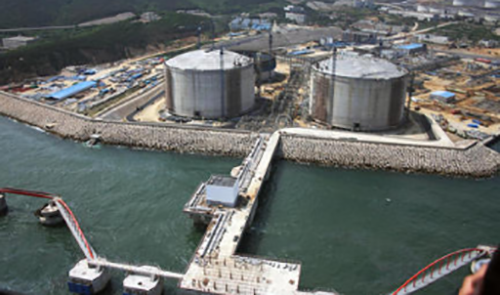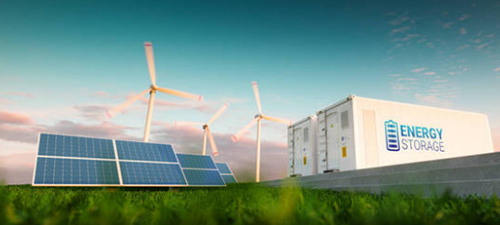Energy is not only the blood of modern industry, but also the cornerstone of normal life. For thousands of years, human beings have mainly relied on fossil energy for maintenance, and the same is true now. But fossil energy will run out one day. So, what can replace fossils and provide clean and sustainable energy for mankind in the future? At present, major countries or regions in the world regard the development of new energy technology as an important breakthrough to lead a new round of energy revolution and technological innovation , and new energy technology is accelerating its iteration at an unprecedented speed. A few days ago, the Institute of Science and Technology Strategic Consulting of the Chinese Academy of Sciences, the Wuhan Literature and Information Center, the Guangzhou Institute of Energy and the Springer Nature team released the “Future Science and Technology Series Report (Phase 1)” – “The Opportunities and Challenges of New Energy Technology Research” ”, an overall analysis of eight different new energy technology fields including solar energy, wind energy, biomass energy, geothermal energy, nuclear energy, hydrogen energy, energy storage, and energy Internet from 2000 to 2019 (especially from 2015 to 2019) and their 20 projects. Systematic analysis of representative technology topics, interviews with Chinese and foreign energy scientists such as Academician Ouyang Minggao and Li Can, quantitative and qualitative analysis of future energy, and focus on the research characteristics of China’s new energy technology from a global scale and research competitiveness.
Hydrogen energy will be an important medium for building a future energy system and realizing energy transformation. The breakthrough of solar fuel technology and its cost reduction may rapidly reduce the dependence on fossil fuels.

According to Guo Jianfeng, a researcher at the Institute of Science and Technology Strategy Consulting of the Chinese Academy of Sciences, through the analysis of published papers, it is found that new energy technology is in a period of accelerated development. From 2015 to 2019, in addition to nuclear energy, the number of published papers in seven technical fields such as solar energy, wind energy, and hydrogen energy exceeded 40% of the total in the past 20 years, more than half of them in 5 fields. Further focusing on the publications from 2015 to 2019, it is found that the global attention to new energy has continued to increase. During the five-year period, a total of 388,416 papers have been published in the field of new energy, with an average annual compound growth rate of about 10%.
Guo Jianfeng introduced that the top 10 papers with the highest frequency of citations can reveal the research directions that are concerned and focused in different new energy technology fields around the world: biomass energy research mainly focuses on lignin pyrolysis, catalysts, pretreatment, microalgae biofuels, biological Refining and other directions; energy storage research mainly focuses on lithium-ion batteries, sodium-ion batteries, lithium-sulfur batteries, positive and negative electrode materials, fast charging technology, etc.; geothermal energy research hotspots include enhanced geothermal system (EGS), geothermal system numerical simulation , geothermal drilling technology, etc.; hydrogen energy research mainly focuses on non-precious metal catalysts, metal organic framework materials, cobalt-based catalysts, bifunctional catalysts, etc.; nuclear energy research mainly focuses on nuclear waste treatment technology, nuclear power plant safety technology, radiation-resistant materials , magnetic confinement nuclear fusion, inertial confinement nuclear fusion, etc.; solar energy research focuses on perovskite solar cells, tandem solar cells, solar photocatalytic hydrogen production, catalysts, semiconductor electrodes, etc.; energy Internet research focuses on smart energy systems, Big data, smart home energy management system, demand response, etc.; the main hotspots of wind energy research include high-power energy converters, wind turbines, numerical simulation of wind power, high-proportion and stable wind power grid connection, etc.

In the future energy system, hydrogen energy is an important secondary energy source for carbon reduction, and the research on hydrogen production, hydrogen storage, and hydrogen energy transportation and utilization is growing rapidly. Among them, hydrogen fuel cells or hydrogen engines, which are the first to receive attention, can transform traditional transportation vehicles and solve urban air pollution and decarbonization problems caused by transportation fuel consumption. In the process of the rapid increase in the scale of renewable energy power generation, the power grid capacity is one of the bottlenecks. Through the electrolysis of water to produce hydrogen, the power grid can flexibly absorb abandoned wind and solar power. Restriction issues offer new paths. At the same time, hydrogen production from renewable energy will also become a sustainable source of green hydrogen in the future.
Hydrogen energy is an important entry point to boost the deep decarbonization of the energy system. Since 2018, many countries, including Japan, South Korea, Australia, the United Kingdom, and France, have released the latest plans in the field of hydrogen energy. Japan has clearly stated that by 2025, hydrogen energy transportation will be fully popularized, and the application of hydrogen energy in power generation, industry and households will be expanded. By 2030, the cost of hydrogen energy use will not be higher than that of traditional energy sources. The EU Hydrogen Energy Strategy released by the European Union in July 2020 proposed the European construction of a “Strategic Roadmap for Hydrogen Energy Ecosystem 2050”. The goal before 2030 is to rapidly reduce carbon emissions in the hydrogen production process and develop other forms of low Hydrocarbons to support the transition to hydrogen production from renewable sources. China is more active in the research and development of key hydrogen energy technologies. China’s earliest deployment of hydrogen energy development is to list hydrogen fuel cell vehicles as one of the development directions of new energy vehicles. However, due to the high cost of hydrogen production technology and hydrogen fuel cells and the layout of hydrogen refueling stations, which restrict the development of the industry, compared with pure electric vehicles and hybrid electric vehicles, hydrogen fuel cell vehicles are still in the stage of demonstration operation. Correspondingly, China’s research activity in key links such as hydrogen production, hydrogen storage, and hydrogenation is also at the forefront of the new energy field.

The research and development of zero-carbon solar fuel technology is the focus of the scientific research community. The report shows that the number of publications and attention paid to solar fuel research is at the forefront, indicating that human beings continue to pursue the use of sustainable natural resources (water, carbon dioxide) and energy (solar energy), in order to obtain through a more ecological and efficient conversion mechanism. Green fuel. Scientists have made a lot of efforts in the fields of photolysis of water for hydrogen production and solar fuel, but there is still a long way to go before the application. For example, photocatalytic hydrogen production is still in the laboratory research and development stage, and how to reduce the cost of solar fuel preparation is still the bottleneck of its industrialization.
Industrialization encounters a bottleneck, who is the “stumbling block” for new energy applications?
Chen Wei, deputy director and research librarian of the Strategic Information Center of the Wuhan Documentation and Information Center of the Chinese Academy of Sciences, concluded that the technology conversion rate of research results in the global new energy field is generally low, and the integration of production, education and research needs to be strengthened. Relatively speaking, the conversion rate of research achievements in energy storage, biomass energy and solar energy is relatively high. Lithium-ion batteries and organic solar cells are technical hotspots of common concern for industrial transformation at home and abroad.
The results show that energy storage, solar energy and hydrogen energy technology research has received the most attention from domestic and foreign markets, while the technologies with relatively high industrial transformation are energy storage, biomass energy and solar energy technologies. The new energy technology hotspots of global and Chinese industry and research focus are concentrated in the fields of battery energy storage and solar photovoltaics, especially lithium-ion batteries and organic solar cells.
Among the new energy technologies, energy storage technology and energy Internet are the most concerned.
Energy storage technology is an important component of modern energy system construction, especially the number of papers published, growth rate and the comprehensive performance of high-quality research on battery energy storage ranked first in the evaluation. According to Chen Wei, renewable energy power generation, smart grids, distributed multi-energy complementary systems, and electric vehicles are all key directions for the low-carbon transformation of power systems in various countries, and energy storage technology is an indispensable technical support for realizing changes in the above fields. The future energy system has soft-link key nodes with flexible, inclusive and balanced functions.

With the wide application of energy storage technology in energy production, consumption and low-carbon smart transformation, the need to improve the safety, energy density, capacity scale, endurance, service life and lower battery costs of energy storage batteries is becoming more and more urgent. Papers and patent analysis show that battery materials such as electrode materials and electrolytes are the research hotspots to improve battery performance. Experts in the field believe that lithium iron phosphate batteries and ternary lithium batteries have successively become the main technical directions of power battery material innovation. The breakthrough route of battery performance mainly includes structural innovation of energy storage battery system, optimization of battery pack space utilization, improvement of battery energy density and safety, and substantial reduction of battery cost.
Energy Internet is a new type of infrastructure for modern energy systems. With the increasing demand for energy and the trend of electrification, the world will accelerate the formation of a diversified energy structure dominated by oil, natural gas, coal, and renewable energy in the future. Structural transformation. Therefore, although energy technology innovation by energy types is still important, breakthroughs in system technologies such as integrated combination, fusion matching, intelligent operation and maintenance, two-way interaction between supply and demand, and multi-network interaction are also particularly important and urgent. At the same time, modern energy systems will inevitably need the support of cross-border science and technology cross-integration such as big data mining, information flow management, detection and network ubiquity, and decision optimization.

Under the global carbon neutrality scenario, the energy system will have the basic attributes of diversity, intelligence, security, and flexibility, which means that the importance of research on energy Internet technology and smart energy system technology is highlighted. Applied basic research, applied technology research and development will continue to receive attention.
According to the analysis of the report, the current energy Internet research still needs to pay attention to the following issues: First, pay attention to the energy Internet architecture and core equipment technology research, in the intelligentization of energy production and consumption, energy Internet system planning, multi-energy flow energy exchange and routing technology, energy intelligence Breakthroughs have been made in transmission technology, intelligent network collaborative control technology, etc. Second, focus on research on energy system big data collection, mining and utilization technology, in energy Internet communication, energy informatization and cyber-physical integration, energy big data application technology, energy Internet Make breakthroughs in management technology and other aspects; thirdly, focus on the transformation of energy Internet technology, and make breakthroughs in research and design, demonstration applications, and implementation of multi-disciplinary interdisciplinary, information network infrastructure and energy infrastructure links.






